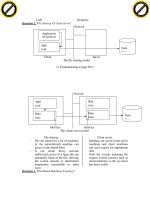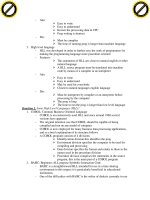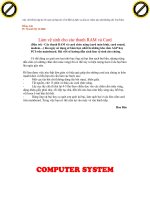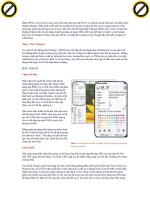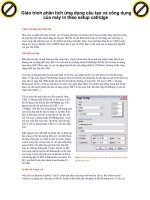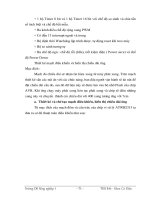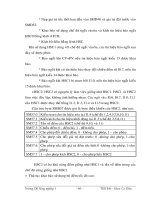Giáo trình phân tích ứng dụng cấu tạo và công dụng của máy in theo setup catridge p7 pptx
Bạn đang xem bản rút gọn của tài liệu. Xem và tải ngay bản đầy đủ của tài liệu tại đây (197.86 KB, 5 trang )
- Ads:
Easy to write
Easy to understand
Known the processing data in CPU
Prog writing is shortset
- Dis:
Must be complier
The time of running prog is longer than machine language
3. High level language
- HLL was developed in order to further easy the work of programmers by
making the programming language more procedure oriented
- Features:
The statements of HLL are closer to natural english or other
natural language
A HLL source program must be translated into machine
code by means of a compiler or an interpreter
- Ads:
Easy to wirte
Easy to understand
May be used for everybody
Closed to natural languages english language
- Dis:
Must be interpreter by compiler or an interpreter before
processing by the computer
The prog is long
The time to run the prog is longer than low level language
Question 2. Some High Level Languages (HLL)?
1. COBOL: Common Business Oriented Language
- COBOL is an exetensively used HLL and since around 1960 several
versions have appeared
- The original intention was that COBOL should be capable of being
compiled and run on any model of computer
- COBOL is now employed for many business data processing applications,
and so a brief explaination of its structure follows
- A COBOL program consists of 4 divisions:
Identifycation division this identifies the prog
Enviroment division specifies the computer to be used for
compiling and processing
Data division specifies the format and relates to these to the
names used in the procedure division
Procedure division comprises the statements in the source
program, this is the main part of a COBOL program
2. BASIC: Beginners ALL purpose Symbolic Instruction Code
- BASIC is a straightforward HLL intended for use in a time-sharing
environment in this respect it is particularly beneficial in educational
institutions
- One of the difficulties with BASIC is the welter of dialects currently in use
Click to buy NOW!
P
D
F
-
X
C
h
a
n
g
e
V
i
e
w
e
r
w
w
w
.
d
o
c
u
-
t
r
a
c
k
.
c
o
m
Click to buy NOW!
P
D
F
-
X
C
h
a
n
g
e
V
i
e
w
e
r
w
w
w
.
d
o
c
u
-
t
r
a
c
k
.
c
o
m
- Essentially BASIC consists of statements made up of verbs & variables.
The verbs are similar to those in COBOL but there is a large to them that
in effect become the addresses of their locations in the main store
- A variable name must be unique and generally consists of one or a few
alphabetic characters, purhaps followed by a digit
3. PASCAL: named after the famous 17
th
century French mathematician
- It was expressly designed as a language to make programming more
systematic and discriplired and in these respects lends itself to structured
programming
- It is however more difficult to learn than are COBOLS BASIC and so is
unliked to be accepted as a language for microcomputers are geared to
BASIC only
Question 3. Operating Systeim?
- Concept of OS:
An OS consists of a suite of programs, one of which, the
master, kernel or exeactive program, remains resident in the
main store. This program controls the other OS programs in
th suites and between them they controls the application
programs
Often the operating system includes various application
packages among its suit of programs. Ex of such software
include: word processing, electronic mail, networking,
speadsheet, graphics and file handling
- Function of OS
Pricrity assignment:
Jobs waiting execution are scheduled according to either a predetermined or a
dynamic assignments plan
Control of multiprogramming
Control of accomplish multiprogramming an “executive” or “supervisor” program
is employed to control the application programs
Communication
Control of data transmission between terminals and the computer, and computer to
computer
Database
Control of DBMS
Software control
Control of assemblers, compilers, utility software, and subroutines so that these
are imediately available when required
Spooling
The control of input/output peripherals in order to achieve their best utilisation
Dynamic allocation
Of main and backing storage, including virtual storage
Operating allocation
Via the console printer or VDU
Debugging and editing new programs
In confunction with the compiler, and passing error msgs to the user
Operation log
Maintaince of details of all jobs carried out by the computer
Click to buy NOW!
P
D
F
-
X
C
h
a
n
g
e
V
i
e
w
e
r
w
w
w
.
d
o
c
u
-
t
r
a
c
k
.
c
o
m
Click to buy NOW!
P
D
F
-
X
C
h
a
n
g
e
V
i
e
w
e
r
w
w
w
.
d
o
c
u
-
t
r
a
c
k
.
c
o
m
Application package control
Especially with microcomputers, as describe above
Chapter 6: TRANSLATORS.
Question 1. Translators?
1. Assemblers
Def: A program that translates assembly language into machine code. Dos
machine instruction is generated for each source instruction
- The resulting program ran only be executed when the assembly process is
completed
Operation:
- Translates mnemonic operation codes into machine code & symbolic
address into machine address
- Includes the neressary linkages for closed subroutines and inserts
appropriate machine code for macros
- Allocates area of storage
- Detects and indicates valid source language instruction
- Procedures the object program on tape or disk required
- The lesting may also include error codes if appropriate. To illustrate the
methods used just think about an assembly program. We must first look at
the directives
A directive is used to control the assembly process, it is not
asembled but is obeyed by the assembler when it is
encouteded, e.g ”END”, is sometimes called a pseudo-
operation code on pseudo-opcode
2. Interpreter
A program which translates and executes each source statement in logical sequence as the
program one instruction at a time, completely translating and executing each instruction
before it goes onto the next
- Interpreter, which deals with the source program one instruction at a time,
completely translating and executing each instruction before it goes onto
the next
- Interpreter seldom produce object code but call upon inbuilt routines
instead
- Some intermediate code is usually produced tempororily
- If an interpreter is used, the source program will be translated every time
the program is executed
- Interpreters are widely used, particular for the programming language
Basic on small computers
Interpriter are used for such things as:
- Handling user commands in an interactive sys
- Debugging programs as they run
- Handling software produced for or by a different computer
3. Compilers:
A program that translates HLL into a machine orientated language, often the machine
code. Many machine instructions are generated for each source statement
- The compiler:
Click to buy NOW!
P
D
F
-
X
C
h
a
n
g
e
V
i
e
w
e
r
w
w
w
.
d
o
c
u
-
t
r
a
c
k
.
c
o
m
Click to buy NOW!
P
D
F
-
X
C
h
a
n
g
e
V
i
e
w
e
r
w
w
w
.
d
o
c
u
-
t
r
a
c
k
.
c
o
m
Translates the source program statements into machine
code
Includes linkage for closed subroutines
Allcocates areas of main storage
Generates the object program on cards, tape and disc as
required
Produces a printed listing of the source and objected
programs when required
Tabulates a lish of errors found during compilation
- Compilers are commonly used for the translation of HLL program
- Compiler translates the whole of the HLL source program into a machine
code object program prior to the program being loaded into main memory
and executed
- If a compiler is used, the same program need only be translated once
Stages of compilation
lexical analysis
systatical analysis
code generation
Chapter 7: SOFTWARE.
Question 1. Application software?
- Application software comprises the programs that are written specifically
to achieve resulting appertaining to the company’s activities
- Application software comes from two source
They produce by themselves
Buy from an external agency
1. Ads and dis of using application packages in house
Ads
- The requirements of the application are more easily met
- There is more control in testing and debugging
- The more control over the usage and support obtained
Dis
- There is a waiting period before the application can be implemented
- Development cost is higher than buying a package
2. Ads and dis of using application package
Ads:
- The packages can be used immediately
- Documentation is generally good
- It can be used on a varisty of machines
- It is cheaper as the costs of the packages are shared between many users
- Comprehensive on line help information and guided tutorials available
- Easily remembered command syntax
- Can be used in confunction with other software in an integrated fashion
Dis:
- Modifications may be difficult for some applications
- Package may be two generalized to suit user needs
- Some features purchased may not be required
Click to buy NOW!
P
D
F
-
X
C
h
a
n
g
e
V
i
e
w
e
r
w
w
w
.
d
o
c
u
-
t
r
a
c
k
.
c
o
m
Click to buy NOW!
P
D
F
-
X
C
h
a
n
g
e
V
i
e
w
e
r
w
w
w
.
d
o
c
u
-
t
r
a
c
k
.
c
o
m
- Support given depends on stability and professionalison of the vendor
- User are required to comply with the owner’s regulations
Question 2. Utility software?
- Certain processing is common to a high proportion of computer users, and
so utility software has been created to cater for this need
- Utility software is intended to be sufficiently flexible to meet most user’s
requirements and is tailored to meet their precise needs by means of
parameter entered prior to use
- Some of the utility programs described below may be incorporated into the
OS that is used with a particular computer
File conversion: this convers the transference of data from
any medium to any other
File copying: an exact copy of a data set is made on to
another lot for the same type of storage medium
File reorganisation: direct access, files over flow records
are stored in designed blocked, this is acceptable up to a
point but from time it si necessary to reorganise the file so
as to remove the overflow
File maintenance(amendment): this procedure involves the
straightforward insertion and deletion of records into or
form sequential files
Sorting: is frequently necessary in order to arrange a set of
records into a certain sequence based on their key values
Dumping routines: a dump routine is used in confunction
with a restfirt program
House keeping operations: there are programs or parts of a
programs not directly concerned with the solution of the
problem in hand
Trace routines: these entails, the dumping, display or
printing of th program or other contents of the main store
during program testing to facilitate error detection
- Utilitys are commonly used to perform these functions:
Copying of files
Sorting of data
Merging of files
Data recovery
Reformating of records by reamanging their fields
File reorganization
Reporting of sys status and usages
Question 3. System software?
There are three main types of memory placement policy:
- First fit
- Best fit
- Worst fit
1. First fit policy, an incoming job is placed in the first available free space large
enough to fit it. This allows the placement decision to be made quickly
2. Best fit policy, an incoming job is placed in the free space in which it fits most
tightly
Click to buy NOW!
P
D
F
-
X
C
h
a
n
g
e
V
i
e
w
e
r
w
w
w
.
d
o
c
u
-
t
r
a
c
k
.
c
o
m
Click to buy NOW!
P
D
F
-
X
C
h
a
n
g
e
V
i
e
w
e
r
w
w
w
.
d
o
c
u
-
t
r
a
c
k
.
c
o
m

